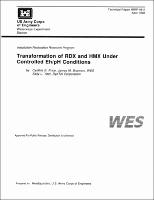Please use this identifier to cite or link to this item:
https://hdl.handle.net/11681/4830| Title: | Transformation of RDX and HMX under controlled Eh/pH conditions |
| Authors: | Installation Restoration Research Program (U.S.) Price, Cynthia B. Brannon, James M. Yost, Sally L. |
| Keywords: | Groundwater RDX HMX Transformation pH Redox potential Soil Groundwater flow Environmental aspects |
| Publisher: | Environmental Laboratory (U.S.) Engineer Research and Development Center (U.S.) |
| Description: | Technical Report Abstract: The presence of hexahydro-1,3,5-trinitro-1,3,5-triazine (RDX) and 1,3,5,7-tetranitro-1,3,5,7-tetrazocine (HMX) in soil and groundwater can present serious environmental problems. An understanding of the processes that control the mobility and transformation of RDX and HMX in soils and water is needed in order to fully evaluate any problems with release of these explosives. The objective of this study was to determine the effects of redox potential (Eh) and pH on RDX and HMX transformation in soil. Laboratory investigations included testing at three redox potentials and four pH levels. A 10:1 (water:soil) suspension spiked with 10 mg of RDX/L or HMX/L was used. The aqueous phase was sampled for RDX, HMX, and transformation products over a period of time. Soils were analyzed at completion of the test incubations. Results in the RDX tests showed that RDX was least stable under highly anaerobic conditions (-150 mV). Oxidizing (+500 mV) and moderately reducing (+250 mV) conditions did not significantly affect RDX stability. Radiolabeled RDX recovery tests showed pH to have a marked effect on mineralization in the anaerobic reactors. At pH 7, 80 percent of the radioactivity was recovered as 14-CO2 as compared with much lower percentages at pH 5 and 8. Results in the HMX tests showed that HMX was least stable under highly reducing conditions, specifically at pH 6. Soil sorption of HMX was affected by Eh and pH. Decreased HMX sorption occurred under highly anaerobic conditions, and increased sorption occurred under highly oxidizing conditions, especially at a pH of 8. The data obtained in this study indicate that RDX in groundwater moving into an area of intense reduction would not persist under neutral pH conditions. RDX moving into areas of oxidizing or moderately reducing conditions would be mobile and persistent. HMX moving into groundwater would be mobile and persistent under all Eh and pH conditions with the exception of highly reducing conditions at or near a pH of 6. |
| Rights: | Approved for public release; distribution is unlimited. |
| URI: | http://hdl.handle.net/11681/4830 |
| Appears in Collections: | Technical Report |
